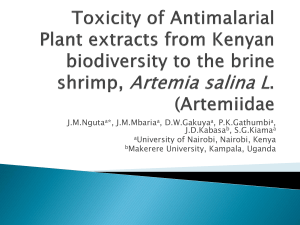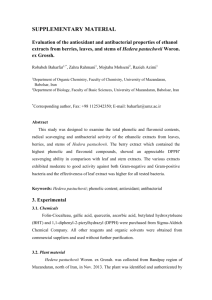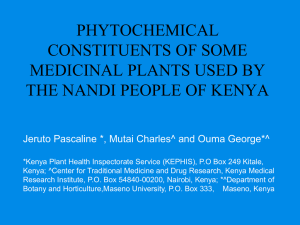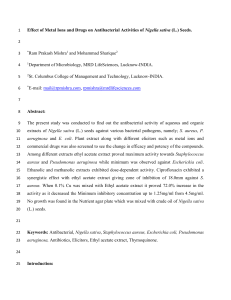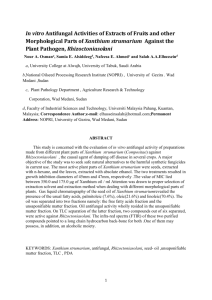2 - itslearning
advertisement
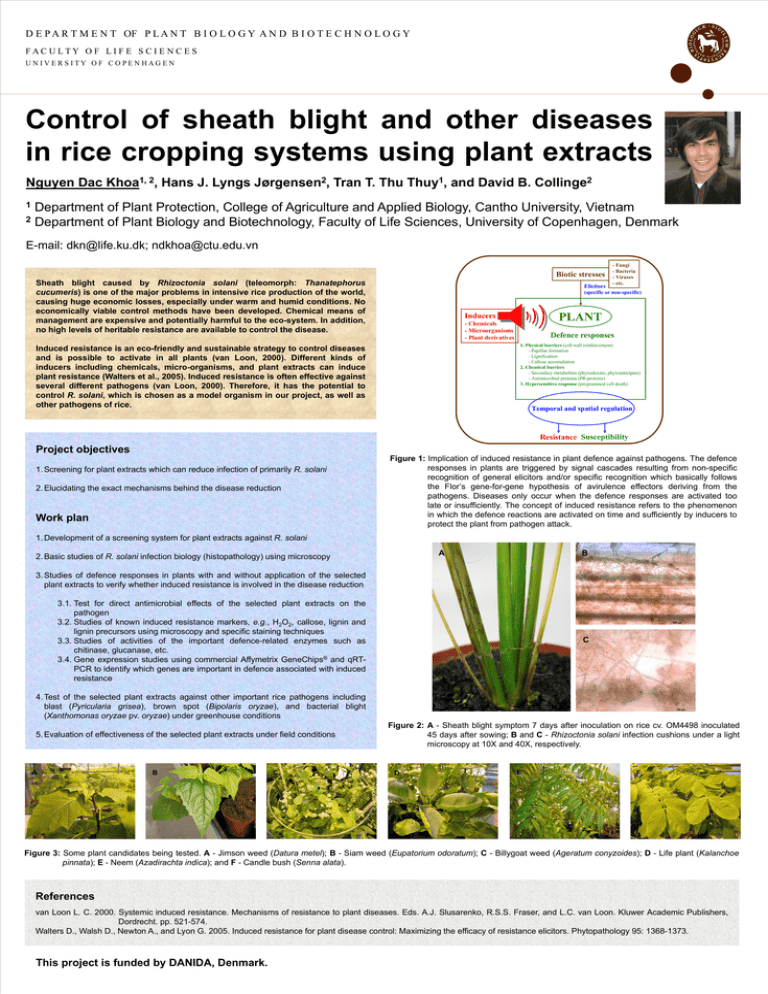
D E P A R T M E N T OF P L A N T B I O L O G Y A N D B I O T E C H N O L O G Y FACULTY OF LIF E S CIENCES UN IVER SITY OF C O PEN HAGE N Control of sheath blight and other diseases in rice cropping systems using plant extracts Nguyen Dac Khoa1, 2, Hans J. Lyngs Jørgensen2, Tran T. Thu Thuy1, and David B. Collinge2 1 Department of Plant Protection, College of Agriculture and Applied Biology, Cantho University, Vietnam 2 Department of Plant Biology and Biotechnology, Faculty of Life Sciences, University of Copenhagen, Denmark E-mail: dkn@life.ku.dk; ndkhoa@ctu.edu.vn Biotic stresses Sheath blight caused by Rhizoctonia solani (teleomorph: Thanatephorus cucumeris) is one of the major problems in intensive rice production of the world, causing huge economic losses, especially under warm and humid conditions. No economically viable control methods have been developed. Chemical means of management are expensive and potentially harmful to the eco-system. In addition, no high levels of heritable resistance are available to control the disease. Elicitors - Fungi - Bacteria - Viruses - etc. (specific or non-specific) PLANT Inducers - Chemicals - Microorganisms - Plant derivatives Defence responses 1. Physical barriers (cell wall reinforcement) - Papillae formation - Lignification - Callose accumulation 2. Chemical barriers - Secondary metabolites (phytoalexins, phytoanticipins) - Antimicrobial proteins (PR-proteins) 3. Hypersensitive response (programmed cell death) Induced resistance is an eco-friendly and sustainable strategy to control diseases and is possible to activate in all plants (van Loon, 2000). Different kinds of inducers including chemicals, micro-organisms, and plant extracts can induce plant resistance (Walters et al., 2005). Induced resistance is often effective against several different pathogens (van Loon, 2000). Therefore, it has the potential to control R. solani, which is chosen as a model organism in our project, as well as other pathogens of rice. Temporal and spatial regulation Resistance Susceptibility Project objectives 1. Screening for plant extracts which can reduce infection of primarily R. solani 2. Elucidating the exact mechanisms behind the disease reduction Work plan Figure 1: Implication of induced resistance in plant defence against pathogens. The defence responses in plants are triggered by signal cascades resulting from non-specific recognition of general elicitors and/or specific recognition which basically follows the Flor’s gene-for-gene hypothesis of avirulence effectors deriving from the pathogens. Diseases only occur when the defence responses are activated too late or insufficiently. The concept of induced resistance refers to the phenomenon in which the defence reactions are activated on time and sufficiently by inducers to protect the plant from pathogen attack. 1. Development of a screening system for plant extracts against R. solani A 2. Basic studies of R. solani infection biology (histopathology) using microscopy B 3. Studies of defence responses in plants with and without application of the selected plant extracts to verify whether induced resistance is involved in the disease reduction 3.1. Test for direct antimicrobial effects of the selected plant extracts on the pathogen 3.2. Studies of known induced resistance markers, e.g., H2O2, callose, lignin and lignin precursors using microscopy and specific staining techniques 3.3. Studies of activities of the important defence-related enzymes such as chitinase, glucanase, etc. 3.4. Gene expression studies using commercial Affymetrix GeneChips® and qRTPCR to identify which genes are important in defence associated with induced resistance C 4. Test of the selected plant extracts against other important rice pathogens including blast (Pyricularia grisea), brown spot (Bipolaris oryzae), and bacterial blight (Xanthomonas oryzae pv. oryzae) under greenhouse conditions 5. Evaluation of effectiveness of the selected plant extracts under field conditions A B C Figure 2: A - Sheath blight symptom 7 days after inoculation on rice cv. OM4498 inoculated 45 days after sowing; B and C - Rhizoctonia solani infection cushions under a light microscopy at 10X and 40X, respectively. D E F Figure 3: Some plant candidates being tested. A - Jimson weed (Datura metel); B - Siam weed (Eupatorium odoratum); C - Billygoat weed (Ageratum conyzoides); D - Life plant (Kalanchoe pinnata); E - Neem (Azadirachta indica); and F - Candle bush (Senna alata). References van Loon L. C. 2000. Systemic induced resistance. Mechanisms of resistance to plant diseases. Eds. A.J. Slusarenko, R.S.S. Fraser, and L.C. van Loon. Kluwer Academic Publishers, Dordrecht. pp. 521-574. Walters D., Walsh D., Newton A., and Lyon G. 2005. Induced resistance for plant disease control: Maximizing the efficacy of resistance elicitors. Phytopathology 95: 1368-1373. This project is funded by DANIDA, Denmark.







